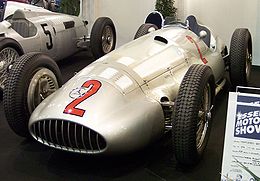Mercedes-Benz W154
 |
|||||
| Category | Grand Prix | ||||
|---|---|---|---|---|---|
| Constructor | Mercedes-Benz | ||||
| Designer(s) |
Max Sailer Albert Heess Max Wagner Rudolf Uhlenhaut |
||||
| Predecessor | Mercedes-Benz W125 | ||||
| Technical specifications | |||||
| Chassis | Oval tubular frame | ||||
| Suspension (front) | Independent suspension with wishbones, coil springs, hydraulic dampers | ||||
| Suspension (rear) | De Dion axle, torsion bars, cockpit adjustable hydraulic dampers | ||||
| Engine | M154 & M163 3.0 litre V12 (60°) supercharged front-engine, longitudinally mounted | ||||
| Transmission | Mercedes-Benz 5-speed manual transmission ZF differential | ||||
| Weight | 980 kg (2,161 lb) (1938) 910 kg (2,006 lb) (1939) |
||||
| Tyres | Continental | ||||
| Competition history | |||||
| Notable entrants | Daimler-Benz AG | ||||
| Notable drivers |
Manfred von Brauchitsch Rudolf Caracciola Juan Manuel Fangio Karl Kling Hermann Lang Richard Seaman |
||||
| Debut |
1938 Pau Grand Prix (non-championship) 1938 French Grand Prix (European Championship) |
||||
|
|||||
| Drivers' Championships | 1 | ||||
The Mercedes-Benz W154 was a Grand Prix racing car designed by Rudolf Uhlenhaut. The W154 competed in the 1938 and 1939 Grand Prix seasons and was used by Rudolf Caracciola to win the 1938 European Championship.
The W154 was created as a result of a rule change by the sports governing body AIACR, which required supercharged engine capacities to be limited to 3000cc. Mercedes' previous car, the W125 used a 5700cc engine and was therefore ineligible to be entered. Mercedes decided that a new car, designed from the outset to comply with the new regulations would be preferable to modifying the existing car and thus designed the W154.
Although using the same chassis design as the 1938 car, a different body was used for the 1939 season and the M154 engine used during 1938 was replaced by the M163. As a result of the new engine, the 1939 car is often mistakenly referred to as a Mercedes-Benz W163.
For the 1938 season, Grand Prix racing's governing body AIACR moved from a formula limited by weight to one limited by engine capacity. This meant Mercedes-Benz's previous car, the W125, was not eligible for entry into 1938 Grands Prix. When designing the new car, Mercedes based the chassis on that used in the W125. The new engine regulations allowed a maximum capacity of 3000cc with a supercharger or 4500cc without. After testing both types, Mercedes chose to use a supercharged 3000cc variant.
The chassis was largely based on that of the preceding W125. The frame was constructed using oval tubes made of nickel-chrome molybdenum to provide a stiff chassis.
The bodywork of the W125 was aluminium metal, which like its predecessors was left unpainted in its bare silver colour. This brought Mercedes' cars during this period, including the W154, the nickname of Silver Arrows.
The suspension was also near identical to the W125. The rear consisted of De Dion tube, a non-independent suspension designed to keep the two rear wheels in parallel using a solid tubular beam. The rear also had hydraulic rear dampers, which were possible to adjust from within the cockpit during a race.
Due to the new regulations, a completely new engine was used for the 1938 season. The M154 was a 3000cc supercharged V12, attaining an output between 425-474 horse power. In 1939, the 2-stage supercharged version of this 2,961.54 cc V12 engine (67.0 x 70.0 mm) recorded a test bed power of 476 BHP (483 PS) at 7,800 rpm.
To compensate for the smaller engine compared to the W125, the W154 had an extra gear with a 5-speed manual transmission. The first gear was protected by a latch to avoid being engaged accidentally.
...
Wikipedia
